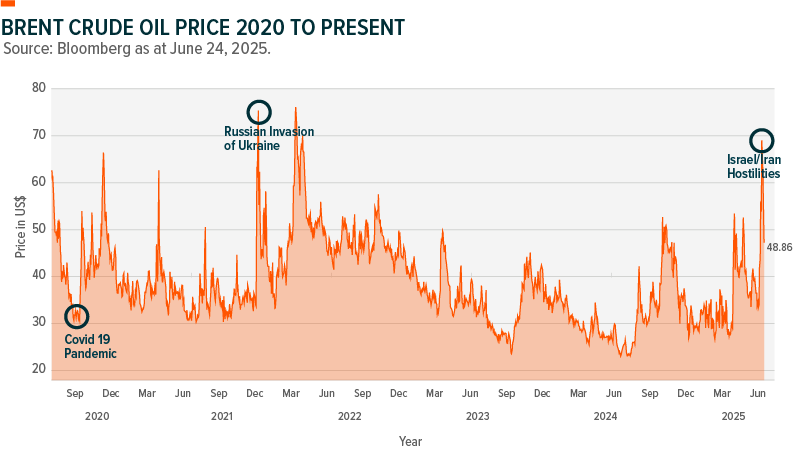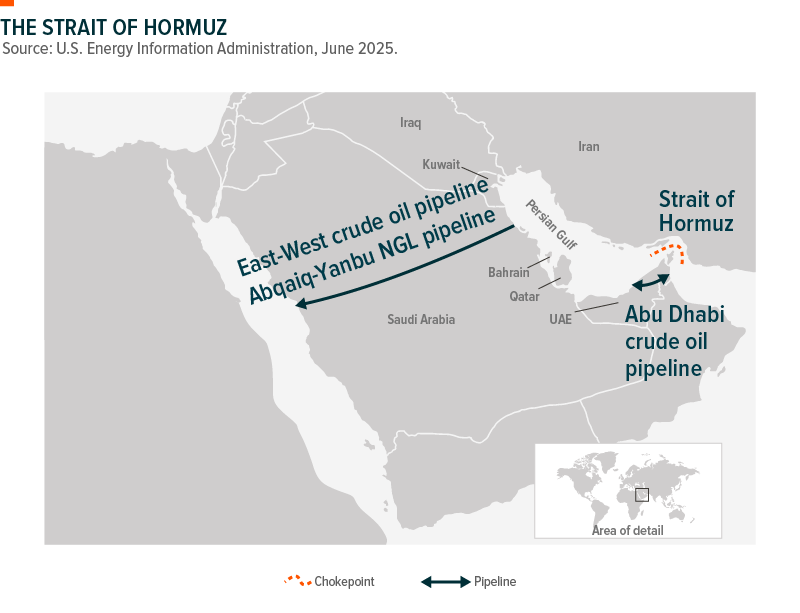Key Takeaways
- Geopolitical tensions have reignited oil price volatility, with Israel–Iran strikes prompting crude to surge 6%—its largest gain since 2022—before retreating on ceasefire news. Fears of disruption to key infrastructure, such as the Kharg terminal and the Strait of Hormuz remain elevated.
- Long-term fundamentals point to softening prices, with rising Organization of the Petroleum Exporting Countries(OPEC) + output, growing global inventories, and slower demand growth expected to weigh on crude. The Energy Information Administration (EIA) forecasts benchmark oil to average US$59–US$61 per barrel through to 2026.
- Oil ETFs offer diversified exposure, helping investors capture upside potential from short-term volatility, while managing stock-specific and geopolitical risks. Canadian policy momentum may further support energy infrastructure and domestic producers.
After a volatile stretch driven by war, pandemic, and inflation, oil markets face a fresh wave of uncertainty. Direct military exchanges between Israel and Iran have revived geopolitical risk, resulting in greater crude price volatility and putting key oil transit routes in focus. At the same time, rising global inventories, shifting demand forecasts, and additional OPEC+ output paint a complex backdrop. And as global conflict and disruption events become more frequent, investors should expect to see greater oil market volatility. For investors, the question is whether today’s headlines signal a structural shift or another short-term dislocation.
Missile Exchange Prompts Oil Price Surge
From the lows reached during a global pandemic to a price spike spurred due to Russia’s invasion of Ukraine, the price of crude oil has seen many price fluctuations in recent years.

Crude oil jumped sharply following direct missile exchanges between Israel and Iran, sparking fears of broader regional instability. Crude surged over 6% on the day of Israel’s strike—its largest single-day gain since 2022—as markets reacted swiftly to the potential for conflict escalation between Iran and Israel. Following a ceasefire announced by U.S. President Donald Trump, it then fell by more than 7% on June 23.
While both nations have a long history of proxy conflict, this marks the most direct and —with energy infrastructure reportedly in the crosshairs. Despite heightened tensions, global oil supply remains uninterrupted – for now. Ultimately, Iran is only responsible for 3% of the world’s oil supply, but its proximity to the Strait of Hormuz allows the country to loom larger over the price-setting dynamics of oil, especially during times of geopolitical tension. While the current Israel–Iran conflict marks a rare direct exchange, its market impact echoes prior episodes, such as 2024’s Red Sea tanker disruptions and the 2011 Arab Spring uprising, both of which triggered sharp, but temporary, oil price spikes. In each case, perceived threats to supply chains, rather than actual shortages, were the primary catalysts for volatility.
The Strait of Hormuz: Strategic Pressure Point
While Israel has targeted military and nuclear sites, attention is shifting to Iran’s Kharg oil terminal, which handles the bulk of its exports. As one of the world’s largest oil facilities, a direct strike would severely limit Iran’s supply and risk broader regional retaliation. Although OPEC’s spare capacity may cushion the blow, such an escalation carries significant diplomatic risk—particularly for oil-importing allies like the U.S.
The Strait of Hormuz, through which flows nearly 20% of global oil supply and 20% of global liquified natural gas (LNG), remains operational.

Iran may retaliate by threatening Hormuz if its Kharg oil terminal is hit, though doing so would hurt its exports. Markets are already on edge, with ships receiving navigation cautions and energy prices reacting to headlines.
Analysts warn that a major infrastructure strike could push oil prices past US$100 per barrel, with ripple effects across the global economy and consumer fuel costs.
Oil Fundamentals Remain Loose
Beyond geopolitics, supply-side dynamics are also in focus. OPEC+ announced another output increase for July—its third in recent months—adding to an already softening backdrop.
According to the International Energy Agency the world oil supply is projected to rise by 1.8 million barrels per day (mb/d) to 104.9 mb/d and by an additional 1.1 mb/d in 2026. Global oil demand is forecast to increase by 720,000 barrels per day in 2025 while growth in 2026 will be held back by a challenging economic outlook and the uptake of clean energy technologies.
The U.S. Department of Energy’s Energy Information Administration (EIA) collects, analyzes, and disseminates energy data. It’s expecting global benchmark crude prices to fall to an average of US$61 per barrel by the end of 2025 and average US$59 per barrel in 2026.
“We expect rising global oil inventories will drive crude oil prices lower over the forecast period,” the EIA said in its most recent outlook, which is revised monthly.
How to Invest
Investors looking to gain exposure to oil and the energy sector have several tools at their disposal. While owning individual stocks is one approach, exchange-traded funds (ETFs) offer another way to participate more broadly within the energy sector.
Oil and energy-focused ETFs offer access to a diversified basket of companies involved in exploration, production, and other energy services. This structure can help reduce the concentration risk of investing in a single stock, while still positioning portfolios to benefit from movements in the price of crude and broader energy market dynamics.

Why ENCC?
Direct equal-weight exposure to some of the largest and most liquid Canadian companies involved in the crude oil and natural gas industry with a Covered Call overlay – which potentially benefits from volatility, mitigates downside risk and offers consistent monthly income.
Why PPLN?
Pipelines typically exhibit lower volatility compared to energy production companies due to their locked-in pricing for transporting energy products, despite being influenced by energy prices.
Why HUC?
By gaining exposure to a crude futures index, HUC offers exposure to the price of crude oil and is denominated in Canadian dollars, any gains or losses resulting from HUC’s investment in U.S. dollar-denominated assets are hedged back to the Canadian dollar, reducing currency risk.
Momentum may be building for Canada’s energy sector, with new legislation poised to accelerate major infrastructure development and attract fresh investment.
Prime Minister Mark Carney’s Bill C‑5 (One Canadian Economy Act) will fast-track “nation-building” projects—including pipelines, power grids, and ports—by imposing a two-year federal approval timeline. The new legislation could be used to build new pipelines and electricity grids, expand port facilities, mines and other resource-related infrastructure projects.
By streamlining permitting and unlocking capital via the Canada Infrastructure Bank, the plan aims to support long-term energy infrastructure growth—potentially boosting the prospects for Canadian energy and mining firms and improving export access amid rising global demand.
Crude markets remain caught between rising geopolitical risk and weakening long-term fundamentals. A direct hit to key infrastructure or the Strait of Hormuz could drive prices above US$100, though rising supply and cooling demand may cap gains.
For investors, oil ETFs offer a way to capture potential upside while managing volatility—making active positioning essential in the current environment.
Related ETFs
ENCC – Global X Canadian Oil and Gas Equity Covered Call ETF
HUC – Global X Crude Oil ETF
PPLN – Global X Equal Weight Canadian Pipelines Index ETF
DISCLAIMERS
Effective June 24, 2022, the investment objectives of the Global X Canadian Oil and Gas Equity Covered Call ETF (“ENCC”) were changed following receipt of the required unitholder and regulatory approvals. For more information, please refer to the disclosure documents of the ETFs at www.GlobalX.ca.
Commissions, management fees, and expenses all may be associated with an investment in products (the “Global X Funds”) managed by Global X Investments Canada Inc. The Global X Funds are not guaranteed, their values change frequently and past performance may not be repeated. Certain Global X Funds may have exposure to leveraged investment techniques that magnify gains and losses which may result in greater volatility in value and could be subject to aggressive investment risk and price volatility risk. Such risks are described in the prospectus. The prospectus contains important detailed information about the Global X Funds. Please read the relevant prospectus before investing.
Certain ETFs are alternative investment funds (“Alternative ETFs”) within the meaning of the National Instrument 81-102 Investment Funds (“NI 81-102”) and are permitted to use strategies generally prohibited by conventional mutual funds, such as the ability to invest more than 10% of their net asset value in securities of a single issuer, the ability to borrow cash, to short sell beyond the limits prescribed for conventional mutual funds and to employ leverage of up to 300% of net asset value. While these strategies will only be used in accordance with the investment objectives and strategies of the Alternative ETFs, during certain market conditions they may accelerate the risk that an investment in ETF Shares of such Alternative ETF decreases in value. The Alternative ETFs will comply with all requirements of NI 81-102, as such requirements may be modified by exemptive relief obtained on behalf of the ETF.
Certain statements may constitute a forward-looking statement, including those identified by the expression “expect” and similar expressions (including grammatical variations thereof). The forward-looking statements are not historical facts but reflect the author’s current expectations regarding future results or events. These forward-looking statements are subject to a number of risks and uncertainties that could cause actual results or events to differ materially from current expectations. These and other factors should be considered carefully and readers should not place undue reliance on such forward-looking statements. These forward-looking statements are made as of the date hereof and the authors do not undertake to update any forward-looking statement that is contained herein, whether as a result of new information, future events or otherwise, unless required by applicable law.
This communication is intended for informational purposes only and does not constitute an offer to sell or the solicitation of an offer to purchase investment products (the “Global X Funds”) managed by Global X Investments Canada Inc. and is not, and should not be construed as, investment, tax, legal or accounting advice, and should not be relied upon in that regard. Individuals should seek the advice of professionals, as appropriate, regarding any particular investment. Investors should consult their professional advisors prior to implementing any changes to their investment strategies. These investments may not be suitable to the circumstances of an investor.
All comments, opinions and views expressed are generally based on information available as of the date of publication and should not be considered as advice to purchase or to sell mentioned securities. Before making any investment decision, please consult your investment advisor or advisors.
For more information on Global X Investments Canada Inc. and its suite of ETFs, visit www.GlobalX.ca
Global X Investments Canada Inc. (“Global X”) is a wholly owned subsidiary of Mirae Asset Global Investments Co., Ltd. (“Mirae Asset”), the Korea-based asset management entity of Mirae Asset Financial Group. Global X is a corporation existing under the laws of Canada and is the manager, investment manager and trustee of the Global X Funds.
© 2025 Global X Investments Canada Inc. All Rights Reserved.
Published June 30, 2025.
